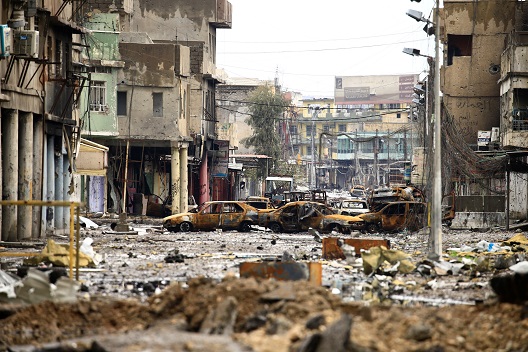 The battle to liberate Mosul in northern Iraq from the Islamic State (ISIS, ISIL, or Daesh) has gone on for four months, reflecting the organization’s stamina and the fact that it has a sophisticated plan for arming, supplying, and defending itself. A combination of Iraqi army and security forces, Shia Popular Mobilization Forces (PMF), Kurdish Peshmerga, Sunni National Mobilization forces, and tribal fighters from the surrounding area, all supported by international forces and air support, have put an impenetrable siege on the city. Although ISIS’s supplies are almost entirely cut off and it faces an estimated 108,500 fighters, it has managed to drag out the fight for Mosul.
The battle to liberate Mosul in northern Iraq from the Islamic State (ISIS, ISIL, or Daesh) has gone on for four months, reflecting the organization’s stamina and the fact that it has a sophisticated plan for arming, supplying, and defending itself. A combination of Iraqi army and security forces, Shia Popular Mobilization Forces (PMF), Kurdish Peshmerga, Sunni National Mobilization forces, and tribal fighters from the surrounding area, all supported by international forces and air support, have put an impenetrable siege on the city. Although ISIS’s supplies are almost entirely cut off and it faces an estimated 108,500 fighters, it has managed to drag out the fight for Mosul.
Mosul is one of ISIS’s key strongholds in Syria and Iraq. It is the city where its leader Abu Bakr Al-Baghdadi announced the birth of the Islamic Caliphate. Mosul also has a unique strategic location on a crossroads between Turkey, Syria, Iraq, and Iraqi Kurdistan. It sits on the new Silk Road that Tehran has spent decades trying to establish to give Iran a land route to the Mediterranean. Each actor taking part in the battle is working to secure its own interests in Mosul.
John Dorian, spokesman for the international coalition, says ISIS only has around 2,000 fighters in the city (less than 2% its attackers’ numbers). Others are certain that the group’s fighting capabilities fall short of what it claims in its propaganda videos and the broader psychological campaign it is waging, and say that in truth, it is on the edge of collapse.
The forces attacking it, which announced the launch of the third stage of the campaign to “liberate Mosul” on February 19, have adopted a scorched earth strategy. There are reports that around 100,000 civilians have fled the battlefield. Images and recordings from Mosul show the scale of destruction in the city due to the intense air strikes and artillery bombardment.
As the battle enters its fourth month, many questions hang over the group’s military capacities in Mosul. A report by Amnesty International said that the group has an “amazing” arsenal, based on what was reported on the ground, not to mention the large quantities of weapons the group may have obtained through illegal supply networks or its own manufacturing operations.
Amnesty said the organization had set up a strategic stockpile of supplies and military hardware it obtained in both Syria and Iraq. The nearest comparable example is the huge collection of armed vehicles it used in the battle for Ramadi in 2015, which reached around 100 battlefield vehicles including American-made Abrams tanks.
On top of traditional weaponry it looted or obtained through the black market, the group also has several kinds of advanced weapons including anti-aircraft systems, guided anti-tank missiles and assault rifles (AKs and American M16s).
It also has several kinds of tanks seized from Iraq and Syrian army bases, including T55s, T72s, M1A1s and 140s, shoulder-launched stinger rockets and Hawk surface-to-air missile batteries.
The group also seized some 3,000 4×4 Humvees during its takeover of Mosul, on top of light weaponry and ammunition worth $500 million which Washington had delivered to Baghdad in 2014.
ISIS videos show that it has American-made TOW anti-tank rocket systems and thousands of four-wheel-drive Toyotas and Land Cruisers, which are able to maneuver in rough desert environments.
On top of all this weaponry, Mosul has difficult geography, in particular many small alleys and high buildings that are effective bases for the group’s snipers. This will drag out the operation to pry the city from its grip, but the operation will ultimately be successful as strikes against the group continue — as was the case in the fight to free Syria’s Kobane (Ayn Al-Arab) in 2015.
ISIS is trying to prolong the battle in order to inflict the greatest possible human and material losses on the attacking forces and portray the fight as a battle against Sunni Arabs, so it can gain a new support base to use as it regroups in the future. The besiegers’ violations, real or perceived, further add to the group’s image as a ‘defender’ of Sunnis. And in the long run it is the victors — the array of Arab and Kurdish, Shia and Sunni, governmental and paramilitary, and international forces — that will have to deal with the denizens’ anger at the destruction of their city.
Ousting ISIS from Mosul will not mean the end of the organization in Iraq. It has been successful since 2004, when it was commonly known as al-Qaeda in Iraq (AQI), in re-clustering and creating sleeper cells. These will find fertile ground in Mosul, enabling them to gather and reproduce amid the chaos of fighting and corruption that has rocked Iraq since 2003, in particular the abuse and marginalization experienced by the country’s Sunni-majority provinces.
Feras Hanoush is an activist from Raqqa, a former doctor with Médecins Sans Frontières in Syria, and a member of Raqqa is Being Slaughtered Silently.
Image: Photo: Cars burnt and destroyed by clashes are seen on a street during a battle between Iraqi forces and Islamic State militants, in Mosul, Iraq March 16, 2017. REUTERS/Thaier Al-Sudani
